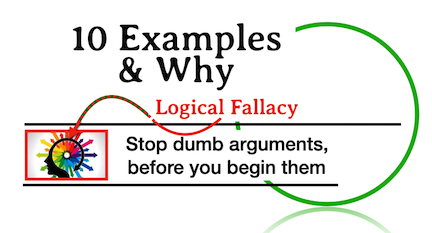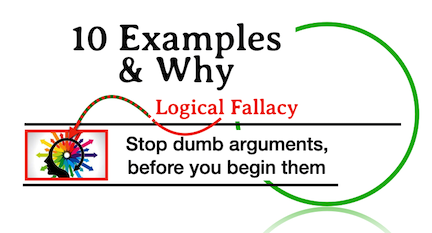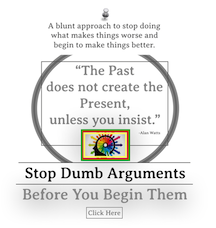A blunt approach to stop doing what makes things worse and begin to make things better.
————————————————————
The Slippery Slope Fallacy asserts that one action or decision will inevitably lead to a chain of events with adverse outcomes, even when there is little or no evidence to support such a progression.
The Slippery Slope Fallacy explained to a Six-Year-Old:
Imagine if someone said, "If we eat one candy now, we'll eat all the candy in the world and get super sick!" That's the slippery slope fallacy. It’s when someone thinks that one small thing will suddenly lead to a huge problem, even though that probably won’t happen.
————————
The Slippery Slope Fallacy explained to an Adult:
Don't catastrophize minor problems, calm first, then address small issues.
〰️
Don't catastrophize minor problems, calm first, then address small issues. 〰️
The phrase "a slippery slope" typically refers to a situation or course of action that is likely to lead to a chain of events with harmful or undesirable consequences. Here are the common meanings and contexts in which it is used:
1. Causal Progression
It suggests that once a certain step or action is taken, it becomes difficult to stop the progression toward a worse or extreme outcome.
Example: "Allowing one exception could lead us down a slippery slope where rules are no longer enforced."
2. Logical Fallacy
In debates or arguments, the "slippery slope" is considered a fallacy when someone assumes that a specific action will inevitably lead to extreme or unlikely results without sufficient evidence.
Example: "If we ban one book, soon they'll ban all books."
3. Ethical Concerns
Often used in ethical discussions to caution against taking a seemingly harmless action that could lead to morally problematic behaviors.
Example: "Euthanasia is a slippery slope—what starts with mercy killing could end with involuntary euthanasia."
4. Policy and Decision-Making
Used to warn against the gradual erosion of principles or standards.
Example: "Accepting small bribes could be a slippery slope to widespread corruption."
5. Behavioral Patterns
Refers to personal habits or decisions where minor indulgences or lapses could lead to significant consequences.
Example: "Skipping one workout might lead you down a slippery slope of not exercising at all."
——————————
The Steps That Create A Slippery Slope Fallacy
Initial Trigger: A small, often neutral, or minor decision or action.
Exaggerated Consequence: A claim that this initial step will lead to extreme and often catastrophic results.
Causal Leap: A failure to demonstrate the intermediate steps or logical necessity of progressing from the initial trigger to the extreme outcome.
Example in a marital context:
"If you spend a night out with your friends, you’ll stop caring about your family and eventually leave me."
——————————
Impact on a Marriage Partner and Family When Repeatedly Employed
When one partner consistently uses the slippery slope fallacy in arguments, it can have profound and damaging effects on the relationship.
Erosion of Trust
The partner accused of triggering disastrous outcomes may feel that their intentions and decisions are unfairly questioned. This undermines their sense of being trusted and respected.
Induced Anxiety and Self-Doubt
Constant exposure to slippery slope arguments can make the targeted partner feel anxious about their choices. They may second-guess themselves, worrying about unintended consequences that are unlikely to occur.
Resentment and Emotional Exhaustion
The partner being accused may grow resentful, feeling manipulated or belittled. Over time, they may emotionally withdraw as a defense against the constant exaggerations and negativity.
Stifling Autonomy
The slippery slope fallacy can be a control tactic, implicitly or explicitly discouraging one partner from making decisions or pursuing interests out of fear of exaggerated repercussions.
Dehumanization and Objectification
When one partner repeatedly employs this fallacy, it can signal a lack of empathy or willingness to engage in nuanced understanding. The accused partner may feel reduced to a caricature of irrational behavior rather than a person with complex motives and emotions.
Communication Breakdown
Over time, the repetitive use of this fallacy can make open, honest communication difficult. The accused partner may feel that dialogue is futile if their actions are consistently misrepresented.
——————————
To repair after using the slippery slope fallacy in a conversation with a spouse, family, or friends
1. "If you let the kids stay up late once, they'll always expect to break the rules."
Explanation: This assumes that a single exception will lead to an uncontrollable pattern, ignoring the ability to set boundaries later.
Reasoned Response (Antidote): "Let’s enjoy this special occasion; tomorrow, we’ll remind them why bedtime is important."
2. "If you don’t text me back immediately, it means you don’t care, and eventually, our relationship will fall apart."
Explanation: This equates one instance of delayed communication with complete emotional neglect, skipping steps in between.
Reasoned Response (Antidote): "I felt anxious when I didn’t hear from you; is everything okay?"
3. "If you spend money on that luxury item, we’ll end up in financial ruin."
Explanation: This exaggerates the financial impact of one purchase without considering the broader financial picture.
Reasoned Response (Antidote): "Let’s review our budget to see if we can afford it comfortably."
4. "If we don’t agree on this now, it’s a sign we’ll never be able to communicate well."
Explanation: This overgeneralizes one disagreement as evidence of a perpetual communication problem.
Reasoned Response (Antidote): "This is a tough topic, but I’m confident we can find common ground with time."
5. "If you go out with your friends, you’ll stop prioritizing your family."
Explanation: This assumes one instance of socializing will lead to ongoing neglect of family responsibilities.
Reasoned Response (Antidote): "I’d love to hear about your plans, and maybe we can schedule some family time soon, too."
6. "If our child doesn’t get straight A’s, they’ll fail in life."
Explanation: This equates academic performance with life success, ignoring other skills and opportunities.
Reasoned Response (Antidote): "Let’s focus on helping them do their best and learn from challenges along the way."
7. "If we let our teenagers dye their hair, they’ll want to drop out of school."
Explanation: This assumes a connection between self-expression and extreme rebellious behavior.
Reasoned Response (Antidote): "Let’s talk about why this is important to them and set healthy boundaries where needed."
8. "If we argue in front of the kids, they’ll grow up emotionally damaged."
Explanation: This assumes one instance of conflict is enough to cause long-term harm, ignoring how it’s resolved.
Reasoned Response (Antidote): "Let’s model healthy conflict resolution so they see how we handle disagreements respectfully."
9. "If we let them quit this activity, they’ll never commit to anything again."
Explanation: This generalizes one decision to all future behaviors, ignoring context and personal growth.
Reasoned Response (Antidote): "Let’s talk about why they want to quit and find other ways to encourage commitment."
10. "If we don’t have a spotless house, people will think we’re failures."
Explanation: This exaggerates the social judgment attached to a single aspect of home life.
Reasoned Response (Antidote): "Let’s focus on making our home comfortable for us and not worry about perfection."
_________________
Why Avoid Slippery Slope Thinking?
Slippery slope fallacies often stem from fear and anxiety. While these feelings are valid, responding with exaggerated assumptions can create unnecessary tension.
It’s important to remember that not every tiny change leads to chaos. Sometimes, changes can actually be beneficial or manageable. So, when someone uses the slippery slope argument, it's good to question whether their fear is based on objective evidence or if they're making a dramatic leap to convince you of something that isn't necessarily true.
Using supportive alternatives helps to address concerns constructively, promote open communication, and foster a sense of teamwork in resolving issues.
Adopt a balanced and constructive perspective.
Calm down first: Take a timeout and self-soothe from the intense reaction. Allow yourself to calm down, then address minor issues with a calm perspective.
Practice Mindfulness: Recognize when fears are escalating beyond evidence. Avoid Shoulda, Coulda, and Woulda thinking.
Focus on the Present: Address the immediate issue rather than speculating about future disasters.
Seek Clarity: Ask questions and explore your partner's intentions rather than making assumptions.
Build Trust: Show confidence in your partner’s ability to make sound decisions.
Contentment with Imperfection (Anti-Perfectionism): Accepting that minor issues are typical and do not define overall success or worth.
Realistic Thinking: Taking an evidence-based approach, asking questions like:
"How likely is it that the worst-case scenario will happen?"
"What’s the worst that could happen, and how would I handle it?"
"Will this still matter in a week, month, or year?"
Calmly Assess Evidence: Once calm, focus on what is occurring and what is the actual problem that is supported by evidence in the “now.”
Rationalizing: Assessing the situation logically and putting the problem into perspective. For example, instead of thinking, "This small error will ruin everything," you might say, "This is a minor setback that I can address and learn from."
Optimizing: Focusing on possible solutions or benefits rather than exaggerating the adverse outcomes. For example, instead of seeing a small mistake as a disaster, view it as an opportunity to improve.
NOTE: A Dumb Argument is hearing but not listening. It lacks accuracy, logic, and reasoning. It ignores evidence and instead relies on fallacies and fear, avoids what is actually occurring, and harms friends, marriage, and family.
———-
Stop Dumb Arguments Before You Make Them.—A blunt approach to stop doing what makes things worse and begin to make things better.
“The Past does not create the Present unless you insist.”



























